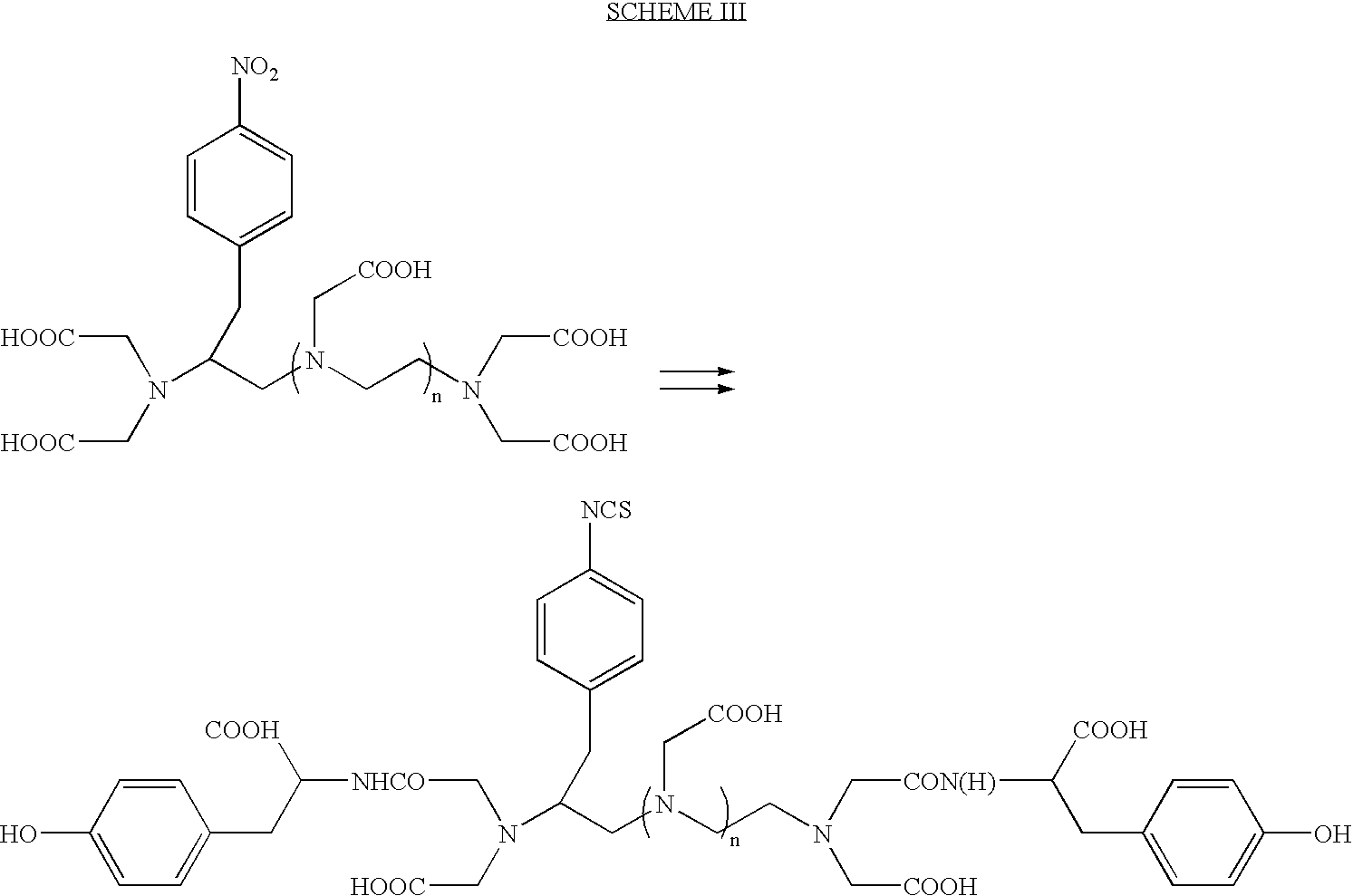Stable radioiodine conjugates and methods of their synthesis
a radioiodine conjugate and stable technology, applied in the field of radioiodine labeled conjugates, can solve the problems non-targeting, compounding of high background radiation, etc., and achieve the effect of improving the specific activity of the prepared conjugates, reducing the formation of aggregates, and improving the quality of iodine antibody conjugates
- Summary
- Abstract
- Description
- Claims
- Application Information
AI Technical Summary
Benefits of technology
Problems solved by technology
Method used
Image
Examples
example 1
Preparation of (BOC)Gly-D-Tyr(O-t but)-D-Lys-OH
[0075]Fmoc-D-Lysine(Aloc) [0.325 g; 0.72 mmol] is dissolved in 5 ml of anhydrous dichloromethane (CH2Cl2), and mixed with 0.55 ml of diisopropylethylamine (DIEA). The solution is then added to 0.5 g of 2-chlorotrityl chloride resin in a 20 ml vial and the contents shaken vigorously for 18 h. The reddish slurry is placed in a column assembly fitted—with a frit and a 3-way stopcock which can be used to either bubble nitrogen through the slurry for mixing purposes or for draining solution off the column and leaving the resin on the column. The solution is drained off; and the resin is washed with 3×40 ml of CH2Cl2:MeOH:DIEA (17:2:1), 3×40 ml of CH2Cl2, 2×40 ml of DMF, 2×40 ml of CH2Cl2 and 2×40 ml of MeOH. The resin is dried under a flow of nitrogen. The Fmoc group is cleaved by adding 40 ml of 5% piperidine in 1:1 (v / v) CH2Cl2-DMF for 10 minutes, draining the solution off, and continuing cleavage with 20% piperidine in CH2Cl2-DMF for 15 m...
example 2
Preparation of Gly-D-Tyr-D-Lys (ITC-Bz-DTPA)-OH
[0076]0.053 g (0.1 mmol) of the product from step-1 is mixed with ITC-Bz-DTPA (81 mg of 80% DTPA content; 20% excess)in water-dioxane, and the pH is adjusted to 8.5. The solution is incubated for 2.5 h at 37° C. (bath). More ITC-DTPA (41 mg) is added, and the pH is readjusted to 8.56. The solution is then incubated for 2 h at the same temperature. Preparative HPLC purification on reverse phase column using a gradient elution of water (0.1% 2C TFA) / 90% acetonitrile-water (0.1% TFA) furnishes 30 mg of (BOC)Gly-D-Tyr(O-tbut)-D-Lys(ITC-Bz-DTPA)-OH as a colorless solid. Analytical reverse phase HPLC shows a single peak with a retention time of 7.54 min. Mass spectrum analysis revealed a M+H peak at m / e 1063 (positive ion mode) and the M−H peak at m / e 1061 (negative ion mode). This material is then treated with a mixture of TFA / CH2Cl2 / anisole for 1 h, and the BOC- and Tyr(O-t but) protecting groups are cleaved off. The title compound is preci...
example 3
Preparation of (MCC)Gly-D-Tyr-D-Lys(ITC-Bz-DTPA)-OH
[0077]0.025 g (0.0138 mmol) of the product from Example-2 is dissolved in 0.5 ml of 0.1 M sodium phosphate pH 7.0. To this, 0.03 g of commercially available sulfosuccinimidyl 4-(N-maleimidomethyl)-1-carboxylate (SMCC) is added and the pH is raised to 7.17. The clear solution is stirred for 1 h. Preparative HPLC on a preparative reverse phase column using the same gradient elution as in Example-1 yields 0.0054 g of the title compound [where MCC stands for the 4-N-maleimidomethyl)-1-carbonyl moiety]. The retention time of the purified material (analytical RP column) is 6.36 minutes. Electrospray mass spectrum analysis showed aN M+H peak at m / e 1126 and an M−H peak at m / e 1124.
PUM
| Property | Measurement | Unit |
|---|---|---|
| pH | aaaaa | aaaaa |
| pH | aaaaa | aaaaa |
| pH | aaaaa | aaaaa |
Abstract
Description
Claims
Application Information
 Login to View More
Login to View More - R&D
- Intellectual Property
- Life Sciences
- Materials
- Tech Scout
- Unparalleled Data Quality
- Higher Quality Content
- 60% Fewer Hallucinations
Browse by: Latest US Patents, China's latest patents, Technical Efficacy Thesaurus, Application Domain, Technology Topic, Popular Technical Reports.
© 2025 PatSnap. All rights reserved.Legal|Privacy policy|Modern Slavery Act Transparency Statement|Sitemap|About US| Contact US: help@patsnap.com



